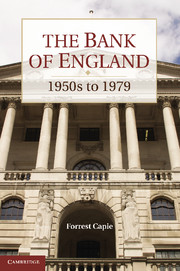Book contents
- Frontmatter
- Contents
- List of Illustrations
- List of Figures
- List of Tables
- Foreword by Mervyn King
- Preface
- Acknowledgements
- Abbreviations and Acronyms
- 1 Introduction and Overview
- 2 The Bank in the 1950s
- 3 The Monetary Setting and the Bank
- 4 The Bank's External Responsibilities to 1964
- 5 From Crisis to ‘Crucifixion’
- 6 Domestic Monetary Policy after Radcliffe
- 7 Other Activities and Performance
- 8 Sterling from Devaluation to Smithsonian
- 9 The Road to Competition and Credit Control
- 10 Competition and Credit Control
- 11 The Secondary Banking Crisis
- 12 Banking Supervision
- 13 Monetary Targets and Monetary Control
- 14 The Bank and Sterling in the 1970s
- 15 The Bank's Freedom to Operate
- 16 Epilogue
- Bibliography
- Index
- Titles in the series
5 - From Crisis to ‘Crucifixion’
Published online by Cambridge University Press: 05 July 2011
- Frontmatter
- Contents
- List of Illustrations
- List of Figures
- List of Tables
- Foreword by Mervyn King
- Preface
- Acknowledgements
- Abbreviations and Acronyms
- 1 Introduction and Overview
- 2 The Bank in the 1950s
- 3 The Monetary Setting and the Bank
- 4 The Bank's External Responsibilities to 1964
- 5 From Crisis to ‘Crucifixion’
- 6 Domestic Monetary Policy after Radcliffe
- 7 Other Activities and Performance
- 8 Sterling from Devaluation to Smithsonian
- 9 The Road to Competition and Credit Control
- 10 Competition and Credit Control
- 11 The Secondary Banking Crisis
- 12 Banking Supervision
- 13 Monetary Targets and Monetary Control
- 14 The Bank and Sterling in the 1970s
- 15 The Bank's Freedom to Operate
- 16 Epilogue
- Bibliography
- Index
- Titles in the series
Summary
The fragile nature of the international monetary arrangements and the delicate position of the two reserve currencies meant that there was increasing discussion and co-operation among the principal participants. The February 1964 Bank Rate rise, for example, was notable for the reason that it was the first occasion on which there was open consultation with US authorities. At the end of 1963, Cromer had told the Chairman of the Fed, Bill Martin that with the economy gathering impetus, his thoughts were turning to an increase. Cromer was keen to co-ordinate any rise with a similar move in the United States in order to leave interest-rate differentials unchanged. In January 1964, the Governor pursued the matter with Hayes and Coombs in Basle, while the Chancellor discussed it with Roosa at a meeting in Paris. Co-operation was perhaps desirable, but negotiations were awkward and required some delicate diplomacy. Telegrams were exchanged between President Johnson and the Prime Minister Macmillan. In Washington, UK Economic Minister Eric Roll was extremely active, whereas in London, only the day before the increase in Bank Rate was announced, Armstrong, Cairncross, Goldman, and Mynors held what was described as an ‘exceptionally frank’ discussion with representatives of the US administration. Although in the event US rates remained unchanged, the cooperation was deemed to have been a success. The only negative was a concern that serious risks had been taken with security, and there could have been another Bank Rate ‘leak’.
- Type
- Chapter
- Information
- The Bank of England1950s to 1979, pp. 193 - 251Publisher: Cambridge University PressPrint publication year: 2010



